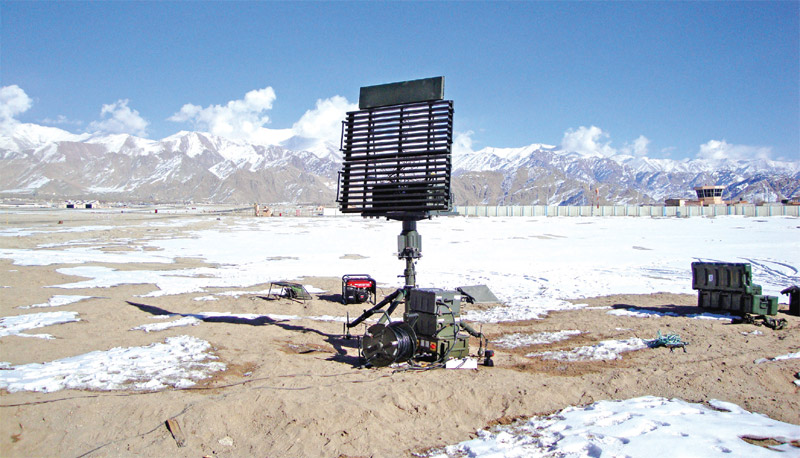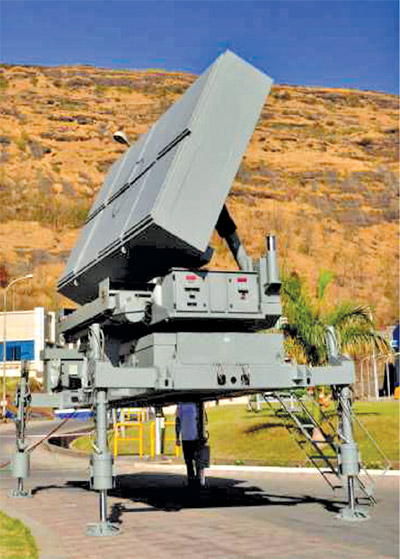Re-evaluate air defence system during peace time to meet challenges of newer missiles
 Prof. Dinesh Kumar Pandey
Prof. Dinesh Kumar Pandey
There is a broad spectrum of aerial threats to Indian airspace ranging from slow and small drones to highly manoeuvrable jets and missiles. These threats can arise during unconventional, conventional wars and even in peacetime. These threats may frequently be together with deceptive electronic countermeasures.
Our national security objectives include the defence of national airspace and the space domain. According to the Union War Book, the country’s overall Air Defence (AD) responsibility has been vested in the Indian Air Force (IAF). AD refers to defensive measures intended to destroy or neutralise the efficacy of aerial missiles or aircraft used by adversaries.
Basic AD Architect
During times of peace, safeguarding of the Indian air space is accomplished through AD and air space management. The AD organisations maintain a 24×7, 365 days of the year operational alert status in order to respond to any aviation threat or airspace violation.
The fundamental functions of an AD organisation are listed below:
(a) AD role requires 24x7x365 monitoring and managing the Indian airspace. Control and reporting organisations are assigned for surveillance of the Indian airspace to detect aerial friendly or foe targets round the clock.
(b) Identify aerial targets quickly to determine the presence of any intruder.
(c) Intercept and destroy hostile targets before they can reach any vulnerable points or areas. Armed aircraft are maintained on active Operational Readiness Platforms (ORP) or Combat Air Patrol (CAP) in order to respond quickly to any aerial threat resulting from the enforcement of airspace control via AD Identification Zones. They are supported by Surface-to-Air Guided Weapons (SAGW) that are maintained in operational readiness.
(d) Providing radar assistance and close control to allied forces following preassigned policies.
(e) Extend all possible assistance to the aircraft in the event of an emergency or contingency.
Since substantial IAF resources are devoted to this peacetime duty, a significant portion of the IAF remains in a state of readiness even during times of peace. This contributes to the IAF’s high responsiveness and enables a rapid and seamless transition to higher levels of conflict.
In the ‘No War, No Peace’ scenario, the number of aerial threats (including those posed by unmanned aerial vehicles) grows constantly. To deter aerial incursions by adversaries/non-state actors, aerospace power must adopt an offensive AD posture by deploying AD sensors well ahead of the occurrence, conducting combat air patrols, deploying long/medium/short range SAMs, counter UAS technology, and conducting surveillance by aerial/space-based platform.
IAF Radars
Radars detect aircraft, satellites, guided missiles and drones. Radar uses radio waves to measure the target’s range, direction and speed. A radar antenna emits an electromagnetic signal from a transmitter to illuminate the aerial targets. Anything that receives this signal will scatter everywhere. The receiver uses the radar antenna’s reflected signal to detect the targets. India had a variety of AD radars. Non-moving object’s reflected energy is repressed and not processed to avoid cluttering up of electronic data. They are broadly categorised as follows.
(a) Static radars: THD-1955, Stars Sapphire, PSM-33, TRS-2215.
(b) Mobile radars: P-12/15, P-18/19, P-30, P-40, ST-68(U/UM).
(c) Aerostats radars: The aerostats are enormous fabric envelopes inflated with helium that a single cable can raise to an altitude of 15,000 feet (4,600 metres). The IAF purchased EL/M-2083 long-range aerostat programmable radars from Israel to improve the country’s air defences in the western sectors.
(d) Present chain of ground radars: The legacy long-range surveillance radar THD -1955 continues to operate effectively for air surveillance. The other modern radars inducted and deployed are medium power radars procured initially from Israel and later indigenised as the Arudhra, LLTR, 3D Central Acquisition Radar (CAR), Low-level lightweight radar (LLLWR), indigenised as the Aslesha radar.
(e) Airborne surveillance and control systems: The IAF has inducted two AWACS from Israel and three indigenously produced Emb 145 AEW&C aircraft.

Indian AD radars
India’s Electronics and Radar Development Establishment (LRDE) is responsible for advancing radar technology. The Defence Research and Development Organisation (DRDO) manages this facility. The LRDE has conducted research and development in radio frequency (RF), algorithmics, and mechanical to establish the many technologies necessary for the construction of radars. As a result of these efforts in research and development, numerous radar subsystems have been developed in order to realise radars on an indigenous level. Multiple radar systems designed by the LRDE have been implemented successfully.
The government took the initiative to create the ecosystem for indigenous radars development decades back. Therefore, the pace of action with the indigenous index was a matter of concern. The evolution pattern of Indian radars is appended below:
INDRA-I: The DRDO created the Indian Doppler Radar (INDRA) series of two-dimensional (2D) radars for the Indian armed forces. INDRA-I is a mobile surveillance radar used for ground-controlled interception radar to identify low-altitude targets. In addition, INDRA-I was developed to serve as a gap filler for air defence, especially against aircraft threats at very low altitudes.
INDRA-II: This mobile surveillance radar was designed to detect targets at low altitudes to accomplish the air force’s demands for air defence. It is a two-dimensional low-flying target detection radar. The radar, installed on vehicles, may also be transported by rail, road or air.
MPR (Arudhra): The DRDO has indigenously designed and developed the radar and mass-produced it by Bharat Electronics Limited (BEL). It’s a phased array radar with electronically steered beams in azimuth and elevation that can detect and track airborne targets in four dimensions. The radar can detect objects up to 300 km away. There is also an option for finding and following moving targets with low radar cross-section (RCS) that are both fast and elusive. The system relies on cutting-edge Digital Beam Forming (DBF) technology implemented via an active aperture phased array. The radar can operate in highly high electromagnetic compatibility (ECM) and interference (EMI) environments. This setup will use interrogations from a nearby Identification Friend or Foe (IFF) system for target identification. The initiative will serve as a driving force in expanding the industrial ecosystem’s capacity for manufacturing.
On 23 March 2023, the ministry of defence signed the contract with the BEL ‘worth more than Rs 2,800 crore’ for the procurement of MPRs ‘Arudhra’ for the IAF. This project is under the Buy [Indian–IDMM (Indigenously Designed Developed and Manufactured)] category.
Rohini: This surveillance radar has been designed to detect and track air targets with reliability, especially in hostile EW operational conditions. The radar employs mechanically scanning pulse-Doppler technology. In addition, the radar is equipped with cutting-edge technology such as a digital receiver and a programmable signal processor, all of which contribute to the device’s excellent resolution, accuracy, and response times and its wide availability of information. With the use of sophisticated software algorithms, several high-speed processors, and cutting-edge digital technologies, the radar has been transformed into a sensor that is not only efficient but also easy to operate, allowing it to provide commanders with airspace awareness around the clock, both in times of peace and conflict.
3D LLLWR Aslesha Mk I: It is a ground-based, three-dimensional, low-level, lightweight surveillance radar that may be deployed in various landscapes, including plains, deserts, mountains and high-altitude regions. At low and medium altitudes, it can identify and track a wide variety of air targets such as helicopters, fighters and unmanned aerial vehicles (UAVs). Using electronically steerable multi-beam technology in elevation offers precise information regarding each target’s height, azimuth and range.
Aslesha Mk II: The LRDE is responsible for the design of the radar. The setup consists of two vehicles: the Sensor Vehicle and the Power Supply Vehicle. It employs a ‘Gallium Nitride (GaN)’ ‘Transmit Receive Modules (TRM)’ based Semi-distributed Active Phased Array Technology. Compared to the Aslesha Mk-1 Radar, this radar can operate at higher elevations and has a greater range and larger height coverage.
Airborne Air Defence Sensors: The IAF has inducted two AWACS from Israel and three indigenously produced Emb 145 AEW&C aircraft as airborne surveillance and control systems.

Network-Centric AD Operations
Radar surveillance assists decision-makers by providing quick and trustworthy data on the status and threats in the area of interest. The C3I system, which handles communications, command and information, relies on data from various sources to make decisions. The C3I’s decision matrix is the product of combining data from a wide variety of intelligence sources. Ground-based radars and airborne platforms like Airborne Early Warning Systems (AEW) conduct air defence surveillance. These sensors identify the aerial threat and alert the AD organisations with the lead time to respond. Timely dissemination of threat intelligence regarding aerial threats facilitates the implementation of active and passive air defences.
Modern IAF ground and air-based radars (AWACS and AEW&C) are networked on the Integrated Air Command & Control System (IACCS) backbone. The IACCS is an automated Air Defence Command and Control Centre that monitors all air force operations. The system can detect, identify, intercept and destroy hostile aerial targets. Modern platforms and networking enable flexibility and multitasking.
Limitations of Radars
Like any technical system, radars are also prone to technical breakdowns and internal and external interferences. The design linked inherent limitations of the radars are:
(a) Depending on the radar’s frequency, power strength and antenna design, they may have a limited range and coverage area. Therefore, technically it is impossible to design a radar that can simultaneously detect all the targets, like small and large-sized targets, ultra-low-level and high-level targets, and slow-moving and fast-moving targets.
(b) Degradation of radar’s performance may be possible by interference, jamming or spoofing.
(c) Radars are required to counter hostile electronic warfare equipment.
(d) Radars are sensitive to natural phenomena such as rain, fog or clutter. They could also be affected by clutter and noise (system and cosmic heat etc.).
(e) They may need help to differentiate between friendly and hostile targets, particularly in dense and complicated situations.
(f) In order to maintain their accuracy and dependability, they might need a lot of maintenance and calibration.
The maintenance and logistic-related limitations with IAF operational radars do play a vital role in ensuring uninterrupted AD operations. The common issues observed are:
- Resolution of teething problems for credible radar systems.
- Poor Spare Support: Radar operations were interrupted for a long duration due to the non-availability of vital spares. At times forecasting of spare requirements is done, but adequate spares were not made available.
- Limited Skilled Maintenance Team: India is geographically too dispersed, and significant time is required to move from one place to another. This limitation adds to prolonging reaction time to attempt any significant technical breakdown.
- Non-adherence to OEM prescribed maintenance schedule. In the long run, these non-standard practices affect the radars’ health.
Way Ahead
Ground-based air defence radars may detect and track airborne targets and provide situational awareness for air defence decision-making. However, all radars must be in good technical health. Cutting-edge technology to build an AD radar network.
(a) Upgrading them with modern technologies, including gallium nitride (GaN), active electronically scanned array (AESA), AI, and ML, to improve performance, reliability, efficiency and flexibility against complex and diverse threats.
(b) Integrating them with other sensors, systems and networks to generate a seamless, comprehensive air picture that can be shared and exploited across domains and allies.
(c) India’s radars do not have micro or mini-UAVs detection capabilities. The IAF’s radars are also vulnerable to ARM and ECM strikes. Thus, diversifying them with different frequency radar. Therefore, diversifying them with different types of radars that are operative on different frequencies may be considered.
(d) The THD-1955 HPR long-range radar undergoes upgrades until the IAF receives its radar system with an active antenna array unit (AAAU). A complete installation has 4 AAAUs facing four directions for 360-degree coverage. HPRs are contracted to Larsen & Taubro.
(e) IACCS will combine 12 HPR long-range radars. The HPR will monitor parabolic (ballistic) hypersonic targets, according to the RFI. Over 2,000 TRMs are expected per radar face.
(f) Air assets such as the AWACS and AWE&C are considered inadequate for any contingency due to the broad borders. Therefore, purchasing or indigenously developing these flexible assets merits consideration on the highest priority.
Re-evaluate Strategy
Modern air threats necessitate comprehensive monitoring and defences against Indian Air Space. The proliferation of ballistic missiles, cruise missiles, and hypersonic weapons outfitted with stealth technology has necessitated the development of radars with superior capabilities.
Recent breakthroughs in computing and digital technology have made it possible to design highly efficient radar systems for encountering today’s threats. Therefore, India must re-evaluate its strategy when it comes to aerial surveillance. India has to implement multi-spectral sensors to identify drones and stealth aircraft in a disruptive environment like electronic warfare.
The current AD environment is critical to the IAF’s network-centric warfare (NCW) strategy. It is more productive and efficient than most alternatives. As the defence in depth requires a cutting-edge AD architect, research and development (R&D) and modernisation of radar system hardware must be planned well in time.

